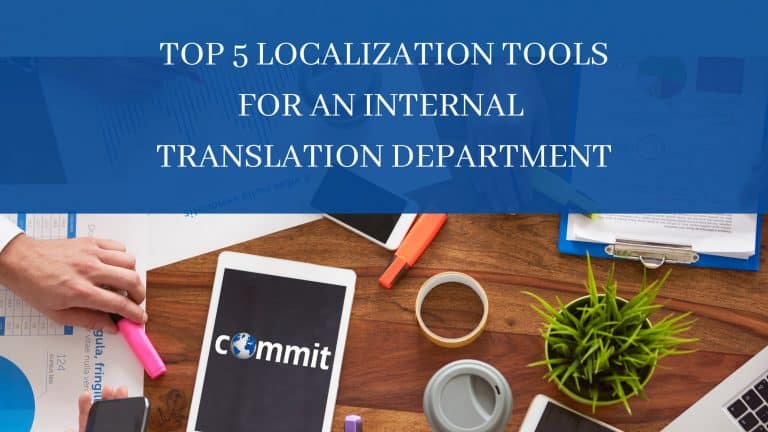|
Listen to Post
|
Listen to this article now:
by Eftychia Tsilikidou, Senior Project Manager at Commit Global
Localization is a very broad process that includes various steps, tools, and procedures. It aims to produce a final product that is unique and culturally appropriate for the intended audience. Translation is only one part of this multifaceted process. Other aspects of the localization process include the adaptation of the graphic design of a product, the adaptation of the content so that it matches and relates to the targeted audience, the compliance with legal and regulatory matters and, last but not least, coding. In other words, localization is the process that encompasses everything that will make a final product, service or document look and feel as if it was originally created for the targeted audience.
As in all aspects of life, technology has played a key role in making the localization process more effective, quick and cost efficient. Furthermore, technology has helped achieve high quality results while eliminating any obstacles that could impede this complex and multi-dimensional process.
Fortunately, the translation and localization tools landscape is very rich and anyone who wishes to optimize its processes has a very broad field of choices. Although having many choices is an encouraging fact, it can undeniably cause confusion and the inability to make a decision. These tools offer features that are important but at the moment there is not one tool that can combine all the features that would cover our needs fully.
Here are the 5 top localization tools any localization department must have in order to make its localization process easier, more productive and cost-effective, and the final product appropriate and attractive for the intended audience.
Production-related Localization tools
Translation Management Systems
CAT (Computer Assisted Translation) tools have evolved to multidimensional systems that include most of the features that the localization process requires. The implementation of such a localization tool is vital to achieve accuracy, consistency, clarity, readability, and overall high quality of the localized content. Most systems include features, such as Terminology management, Translation Memory databases and Translation Quality Assurance functionalities that can be accessed through the necessary Translation Editor. Cloud-based TMS systems are more flexible and reliable and almost all TMS developers offer cloud-based solutions, gradually abandoning desktop applications.
Such systems have the ability to manage many different file formats and handle complex, multilingual, and high-volume projects helping users monitor projects’ progress. Furthermore, many such systems provide reporting and analytics which can help monitor certain indicators.
This is the broad framework of most Translation Management Systems. However, these systems are further categorized to cover more specific needs. Hence, there are TMS systems that are mainly oriented to cover the localization needs of developers, others that specialize in website or software localization and others that are more appropriate for games and mobile applications.
Quality Assurance tools
Although all translation management tools include a Quality Assurance feature, stand-alone Quality Assurance tools allow deeper and more sophisticated checks. These tools use translation assets, such as translation and terminology databases, as well as customized checklists along with the translated bilingual files to check term-based and sentence-based consistency, punctuation, grammar, capitalization, and spelling. They are essential to capture any human-related errors that usually skip the attention of the translator and the editor and eliminate such first-level quality issues. Furthermore, most Quality Assurance tools offer powerful search functions, which, if used wisely, can serve as a valuable and multidimensional asset for concordance search during the translation process, since they can combine many resources of different types offering simultaneous search in all the preset resources, saving users valuable time and effort.
Localization Testing tools
Testing plays a vital role in Localization. The final product must be tested in its original environment after the translation and/or adaptation process is completed in order to eliminate any bugs or issues that could have been created in the process. Depending on the product, such tools can provide test-case scenarios and facilitate set-up, scheduling, and monitoring of the testing process.
DTP and Design Tools
Desktop publishing goes hand-in-hand with the localization process. Given that each language has its own structure and requirements, the output is never the same after the translation or localization process and final set-up of the content in the file is a necessity. In cases where graphic re-design is part of the localization process, the availability of such tools is even more vital.
Administration-related Localization tools
Translation Business Management Systems
For organizational purposes and the smooth operation of any internal translation department, a translation business management system is key. It helps maintain a comprehensive customer and (internal and external) supplier database and provides the appropriate environment for project management and administration activities. It helps users search for suppliers (translators, editors, graphic designers or other), create orders and measure work efforts, evaluate project profitability, prepare and send invoices and make payments.
The Translation and Localization industry is a fascinating world, that provides ample space for creativity and unique approaches. Hence, the choice of tools is as unique. Every company can choose its own approach and pave its own path.
If you need help selecting the tools that are most appropriate for the needs of your organization, Commit Global offers localization consulting services for internal translation departments. We can help with the design and implementation of your department, language asset creation and maintenance, tool selection and your overall localization strategy. Get in touch for more details!









